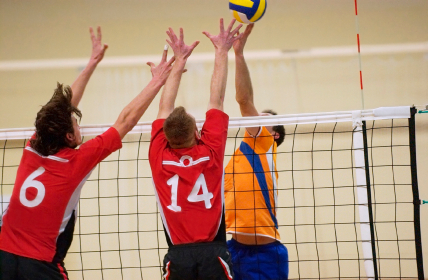Lower back pain is a common among the general population, with studies suggesting that as many as 80-90% of people will experience some sort of back problem at some point in their life. While persistent and nagging back pain is considered normal among older people and is generally less common in younger populations, a Japanese study reports a much higher incidence among youth volleyball players. 
Compared to most sports, volleyball involves a great deal more standing and crouching with the arms extended over the head and jumping. Young volleyball players, particularly taller players in the midst of a growth spurt are at increased risk of back injury. Repeated spikes and blocks places increased stress on the spine. Players who jump serve will often hyper-extend the spine to generate a more powerful follow-through, increasing loading along the entire spine. Players on the back row and "setters" may experience less regular pain than the taller players on the front row, but the constant diving and landing on hard surfaces is hard on the hips, knees, back, and shoulders. Add to the mix the hard floor of a volleyball court and ten to thirty hours a week of practice and play and no wonder so many volleyball players have sore backs!
Chronic back pain
While most athletes experience some sort of strain or fatigue in their lower back at some time or another, here are the warning signs of a more serious back problem:
- Pain that has lasted for greater than 1 week and is either not improving or getting worse;
- Pain during rest which prevents sleep or causes the the athlete to wake up frequently;
- Difficulty sitting in class at school;
- Complaints when performing basic chores around the house, such as emptying the dishwasher or folding laundry;
- Experiencing pain on the court when jumping, landing, or rotating body to attack the ball;
- Chronic pain ranging from an ache to a shooting or throbbing pain down the buttocks and legs.
Preventing back pain
While recognizing and treating back pain is critical, preventing the pain from occuring in the first place is better. Here are some ways to prevent back pain:
- Core and Balance Training - Exercises to strengthen and balance the muscles in the lower back, stomach, and legs balance can prevent damaging rotational torque during jumping and landing;
- Cross-Training: Swimming, biking, strength training, and aerobic classes can help.
- Play other sports: Playing sports other than volleyball uses and develops different muscles, which minimizes the risk of overuse injuries.
- Time off: While they may still play another sport, it is recommended that athletes take at least a 2-3 month break from their primary sport. This allows repetitively stressed parts of the body to heal, become stronger, and prepare for next season.
Source: Hangai M. et al, Relationship Between Low Back Pain and Competitive Sports Activities During Youth, Am J Sports Med 2010; 38: 791-796; published online before print January 5, 2010, doi:10.1177/0363546509350297.
Posted May 8, 2012








